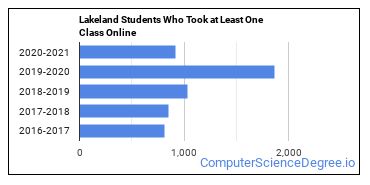Lakeland University Computer Science Programs
Lakeland University is a private not-for-profit institution located in Plymouth, Wisconsin. Lakeland is located in the countryside, which is perfect for students who enjoy a rural lifestyle.
Featured schools near , edit
Where Is Lakeland University?

Contact details for Lakeland are given below.
| Contact Details | |
|---|---|
| Address: | W3718 South Drive, Plymouth, WI 53073 |
| Phone: | 920-565-1000 |
| Website: | www.lakeland.edu |
How Do I Get Into Lakeland?
You can apply to Lakeland online at: https://lakeland.edu/aboutus/apply
Admission Requirements for Lakeland
| Submission | Required? |
|---|---|
| High School GPA | 1 |
| High School Rank | 3 |
| High School Transcript | 1 |
| College Prep Program | 5 |
| Recommendations | 5 |
| SAT or ACT Scores | 3 |
| TOEFL | 1 |
How Hard Is It To Get Into Lakeland?
Approximately 54% of accepted students are men and 46% are women. The acceptance rate for men is 100%, and the acceptance rate for women is 99%.
Can I Afford Lakeland University?
The net price is calculated by adding tuition, room, board and other costs and subtracting financial aid.
Student Loan Debt
It's not uncommon for college students to take out loans to pay for school. In fact, almost 66% of students nationwide depend at least partially on loans. At Lakeland, approximately 97% of students took out student loans averaging $6,740 a year. That adds up to $26,960 over four years for those students.
Lakeland University Undergraduate Student Diversity

There are also 606 graduate students at the school.
Gender Diversity
Of the 751 full-time undergraduates at Lakeland, 48% are male and 52% are female.

Racial-Ethnic Diversity
The racial-ethnic breakdown of Lakeland University students is as follows.

| Race/Ethnicity | Number of Grads |
|---|---|
| Asian | 30 |
| Black or African American | 71 |
| Hispanic or Latino | 72 |
| White | 356 |
| International Students | 8 |
| Other Races/Ethnicities | 214 |
Geographic Diversity
Wisconsin students aren't the only ones who study at Lakeland University. At this time, 16 states are represented by the student population at the school.
Over 27 countries are represented at Lakeland. The most popular countries sending students to the school are Japan, China, and Kenya.
Online Learning at Lakeland University
The following chart shows how the online learning population at Lakeland has changed over the last few years.

This school is the 4th most popular in Wisconsin for online learning according to the online graduations recorded by the Department of Education for the academic year 2022-2023.
The following table shows the 1-year growth rate of Lakeland majors that offer at least one online course. This table only includes majors with positive growth.
| Major | 1-Year Growth Rate |
|---|---|
| General Computer & Information Sciences | 19% |
Lakeland University Computer Science Concentrations
The table below shows the number of awards for each concentration.
| Major | Bachelor’s | TOTAL |
|---|---|---|
| General Computer & Information Sciences | 42 | 42 |
| TOTAL | 42 | 42 |
References
*The racial-ethnic minorities count is calculated by taking the total number of students and subtracting white students, international students, and students whose race/ethnicity was unknown. This number is then divided by the total number of students at the school to obtain the racial-ethnic minorities percentage.
- College Factual
- National Center for Education Statistics
- Image Credit: By self under License
More about our data sources and methodologies.
Featured Schools
 Request Info
Request Info
|
Southern New Hampshire University You have goals. Southern New Hampshire University can help you get there. Whether you need a bachelor's degree to get into a career or want a master's degree to move up in your current career, SNHU has an online program for you. Find your degree from over 200 online programs. Learn More > |
